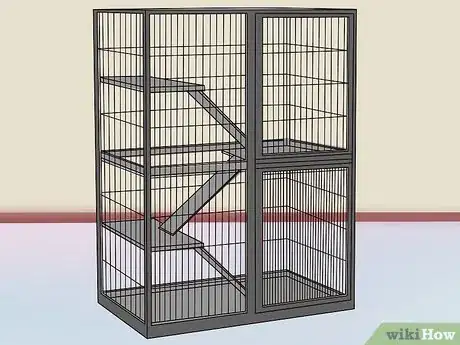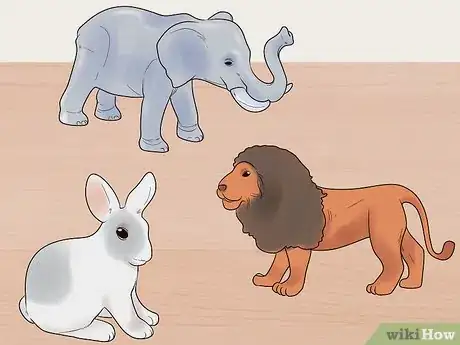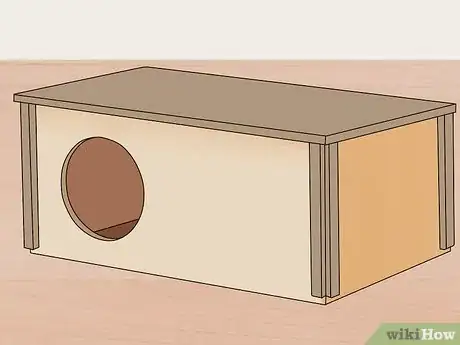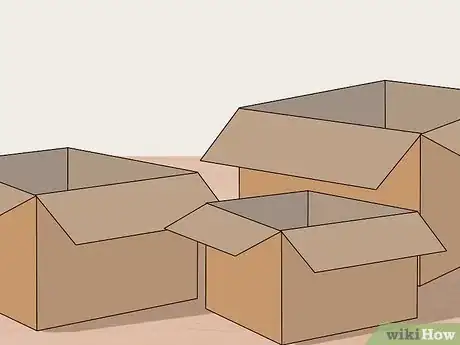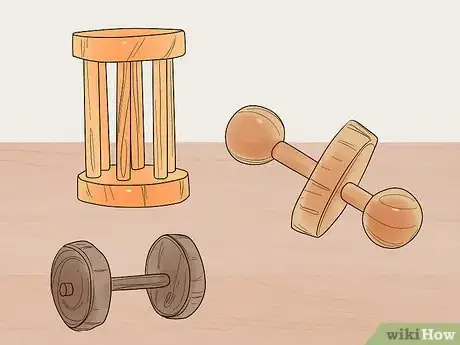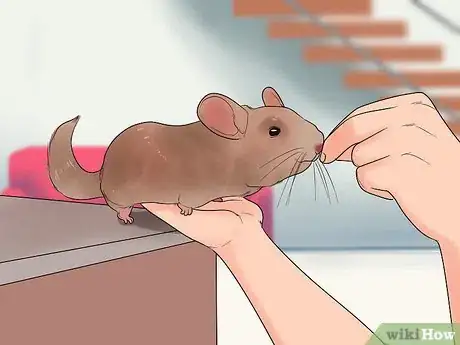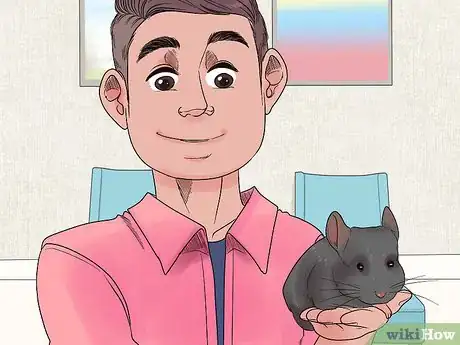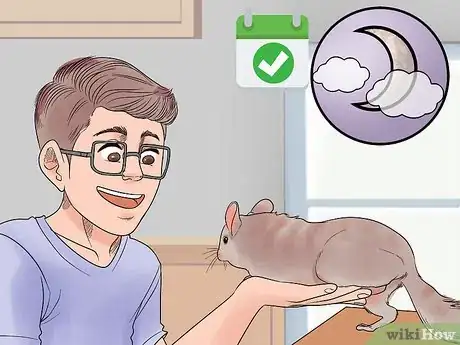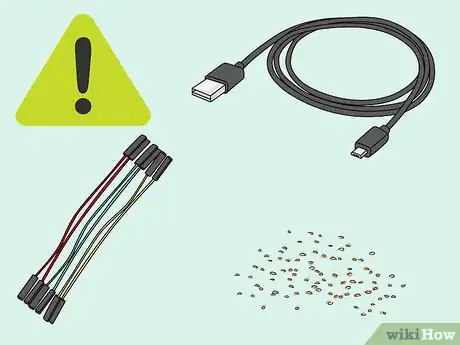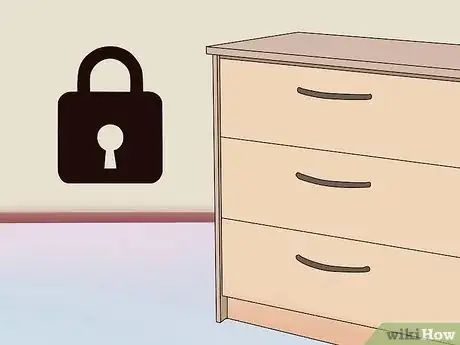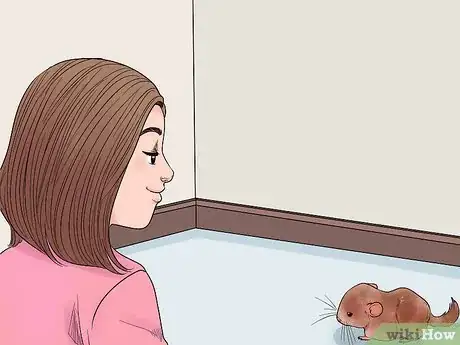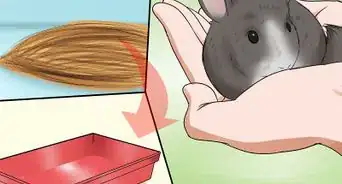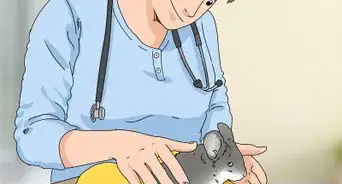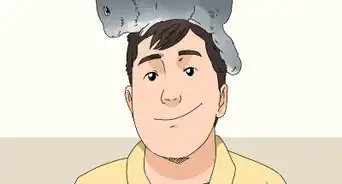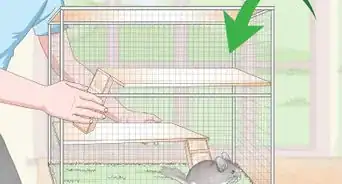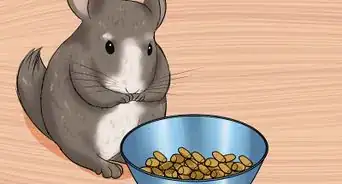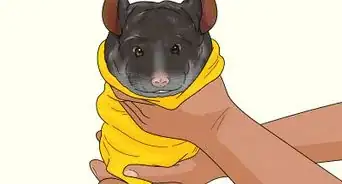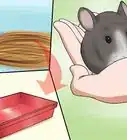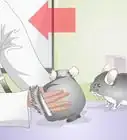This article was co-authored by Pippa Elliott, MRCVS. Dr. Elliott, BVMS, MRCVS is a veterinarian with over 30 years of experience in veterinary surgery and companion animal practice. She graduated from the University of Glasgow in 1987 with a degree in veterinary medicine and surgery. She has worked at the same animal clinic in her hometown for over 20 years.
This article has been viewed 20,859 times.
Like most pets, chinchillas love to play and be played with. Playing is beneficial for their health and lets them express themselves in their own unique way. However, chinchillas like to do their own thing, so don't feel down if your interactions with them while playing are rather limited. That said, there's plenty for you do to help make their playtime experience the most fun possible, both inside and outside of their cages.
Steps
Making Your Chinchilla's Cage Fun
-
1Put your chinchilla in a large cage. The higher the cage’s ceiling, the better. Chinchillas are excellent jumpers and climbers and enjoy using these talents. Consider a multi-level cage for them or one with many sturdy platforms.[1]
- Avoid cages with wire flooring to avoid potential damage to your chinchilla’s feet.
- Avoid plastic cages and items as your chinchilla will likely chew through them. Plastic cage floors are both fine and encouraged.
-
2Set up a large exercise wheel. Many chinchillas enjoy running, and a wheel is a good way for them to get exercise while in a contained environment. Make sure the base of the wheel is solid and not made of spokes; your chinchilla can break its legs on the latter.Advertisement
-
3Fill the cage with pet toys made for rodents. These will be for your chinchilla to chew on. You can provide wood blocks or branches, but make sure the wood you're giving them is free of pesticides. Durable parrot toys work in this case as well if you have access to them.[2]
-
4Add in a hiding house. You can use wood or a clay pipe for this. This will be your chinchilla's favorite place, and will likely end up as its nest. It's a prey animal, so having a hide house helps it feel secure.[3]
- If you have multiple chinchillas they should each have their own hide houses.
Playing with Your Chinchilla Outside Its Cage
-
1Let it run up and down the stairs. This activity is similar to letting it run on its wheel or climb its cage, only on a much greater scale. If you aren’t comfortable with letting your chinchilla climb the stairs, a small step ladder will suffice. This way you can keep it in your sights, and it won't be climbing something too high. [4]
-
2Give it cardboard boxes to chew. Cereal boxes, snack boxes, and tissue boxes all work. Your chinchilla can destroy these to their heart's content without causing any real damage to your home. It’s a win-win situation.
-
3Have chew toys available for them during playtime outside of the cage. This will not only help to strengthen your chinchilla's teeth, but you can also use them as a distraction to keep them from chewing on something they're not supposed to.
- Any toys or props you have in mind for your chinchilla during playtime should be different from the ones they have in their cage. This way they’ll give them attention while being out and about.
-
4Offer your chinchilla a treat while they play if you want them to come to you. This is a good way to get them to climb on your hand when playtime is over. Raisins are one their favorites.[5]
- Chinchillas do not like to be chased. If they don't come, insist a little more with the treat and be patient.
- Be sure to leave out plenty of food and water during the play session so your chinchilla’s blood sugar doesn’t dive from all their exercise.
-
5Scratch them as you pet them. Most of your interaction with your chinchilla will happen at this stage. Chinchillas don’t like to be contained, so it’s best to let them come to you and to release them whenever they give begin to squirm or resist. When you do have a hold of them, however, opt to scratch them over petting; they prefer it.
- Scratch under the chin and on the front forepaws. That tends to be their favorite.
Keeping Your Chinchilla Safe
-
1Schedule play time for your chinchilla in the evenings. Chinchillas are both nocturnal creatures and creatures of habit. They prefer a schedule rather than spontaneity. Pick a time that works for you in the evening and take your chinchilla out of its cage for some fun. [6]
-
2Remove all chewable objects from the chosen play space. Aside from running and jumping, chinchillas love to chew on things, especially on things they're not supposed to. After you’ve picked a room you want to play in, make sure you pick anything up off the floor that can be chewed or accidentally swallowed.
- Look out for wires, cables, clothing of any kind, and any small debris you might come across.
- Your chinchilla will also chew on your baseboards, so avoid using rooms that have them.
-
3Close off all possible hiding places in the room. Chinchillas are explorers and can easily fit into tight spaces. It’s too easy for you to lose them somewhere in your house because of this. Be sure to cover any holes, and close off any areas (like closets and bathrooms) that aren’t within your line of sight or lead out of your designated space. [7]
-
4Supervise them at all times. You’ll find that chinchillas love to get themselves into trouble. Even if you feel you have thoroughly proofed the room, try to never take your eyes off of them.[8]
- Make sure you remove other pets from the room, like cats and dogs, before you let your chinchilla out. Larger pets could harm your chinchilla, so keeping them separated during playtime is a necessary precaution.
Warnings
- Watch for temperatures exceeding 80 °F (27 °C) degrees as they can be fatal to your chinchilla.⧼thumbs_response⧽
References
- ↑ https://cvm.ncsu.edu/wp-content/uploads/2016/12/Caring-for-your-Chinchilla.pdf
- ↑ https://cvm.ncsu.edu/wp-content/uploads/2016/12/Caring-for-your-Chinchilla.pdf
- ↑ https://www.petsuppliesplus.com/en/Resource-Center/Small%20Pet/Chinchillas
- ↑ https://www.cuteness.com/article/play-pet-chinchilla
- ↑ https://www.bluecross.org.uk/pet-advice/caring-your-chinchilla
- ↑ https://www.bluecross.org.uk/pet-advice/caring-your-chinchilla
- ↑ https://www.cuteness.com/article/play-pet-chinchilla
- ↑ https://www.bluecross.org.uk/pet-advice/caring-your-chinchilla
